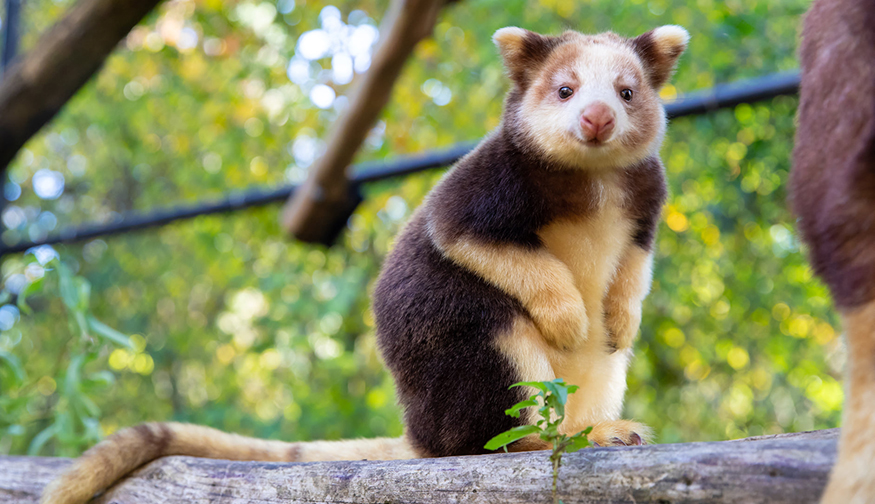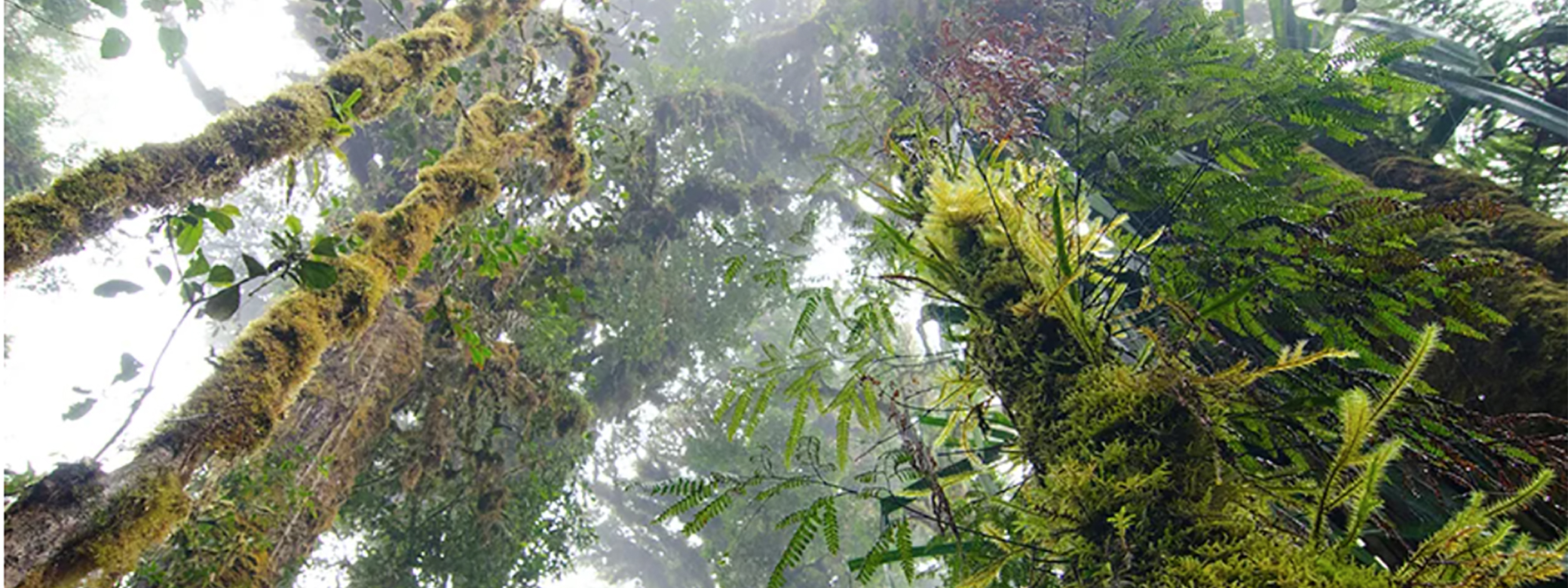
If you’re unfamiliar with tree kangaroos, you’re not alone. The elusive animals, known as “ghosts of the cloud forest,” live in towering trees in Papua New Guinea’s high-elevation rain forests. Hidden by vegetation, they are tremendously difficult to study. Yet Lisa Dabek, senior conservation scientist at Seattle’s Woodland Park Zoo (WPZ), has devoted decades to understanding and protecting them.
Dabek (PhD, Psychology, 1994) first learned about tree kangaroos as a graduate student in the 1990s, studying animal behavior in the Department of Psychology in the UW College of Arts & Sciences. She contacted WPZ about conducting research there for her graduate studies, expressing particular interest in mother-young interactions. A zookeeper mentioned that two of the zoo’s tree kangaroos currently had joeys in their pouches.

“I didn’t even know what a tree kangaroo was,” Dabek recalls. “There had been no scientific research on them. That was unusual in the world of biology, especially for a medium-sized mammal.”
Intrigued, Dabek spent hours at the zoo each week observing tree kangaroos. Unlike their ground-dwelling kangaroo relatives, tree kangaroos are adapted to live in the soaring trees of cloud forests. Dabek describes them as shy and solitary, though offspring (called joeys) stay with their mothers for an unusually long time compared with other kangaroos and other similarly sized mammals. “The mom spends a lot of time training the young how to navigate in an arboreal world,” says Dabek. “It’s a very close bond.”
Dabek developed her own close bond to tree kangaroos. After earning her PhD studying the reproductive biology and behavior of tree kangaroos and working as an academic advisor in the UW's Institute for Environmental Studies, she founded the WPZ’s Tree Kangaroo Conservation Program (TKCP), a collaboration between US scientists and communities in Papua New Guinea. Together, they have ensured that endangered tree kangaroos — and other creatures in the cloud forest — survive and thrive.
Appealing to Landowners
Dabek was interested in animals from an early age. Growing up in New York City — “as far from the wilderness as you can imagine,” she says — ants from her apartment’s terrace were her first research subjects. She also loved visiting the Bronx Zoo. After earning an undergraduate degree in biology and environmental studies from UC-Santa Cruz, she worked at the Smithsonian Institution National Zoo. Then came graduate studies at the UW, with research at WPZ.
“From my work at the National Zoo, I knew that zoos are a place where good research can take place,” says Dabek.” I made the connection to the Woodland Park Zoo early on.”
After grad school, Dabek wanted to study endangered tree kangaroos in their natural habitat. She secured a grant to travel to Papua New Guinea, hoping to establish a conservation research project. It took a second trip with colleague Will Betz (BA, Anthropology, 1988) to finalize a site. They chose Papua New Guinea’s isolated Huon Peninsula, the only place where Matschie’s tree kangaroos — the species at the WPZ — are found in the wild. (Of the 14 species of tree kangaroo, two live in Australia, the rest on the island of New Guinea.)
We approached it as creating a sustainable resource rather than ‘You’re wrong, don’t hunt.' We didn’t go in trying to tell them what to do. That was one of the big ways we’ve been successful.
Local villagers own more than 90 percent of the land in Papua New Guinea, so Dabek and Betz could not establish a field site without their permission. That meant convincing landowners of the benefits of the project. Aware that the people of the Huon Peninsula hunt tree kangaroos for meat and fur, and that the tree kangaroo population was dwindling, the researchers explained how conservation efforts would increase the tree kangaroo population and improve hunting.
“We approached it as creating a sustainable resource rather than ‘You’re wrong, don’t hunt,’” Dabek says. “We didn’t go in trying to tell them what to do. That was one of the big ways we’ve been successful.”
Landowner Mambawe Manaono granted permission for them to set up a research site in his forest and agreed to stop hunting in that area. With the help of Manaono and his family — skilled tree kangaroo trackers and hunters — Dabek then had her first sighting of Matschie’s tree kangaroos in their natural habitat. “It was incredible to see them in the wild,” she recalls. “That was the real beginning of our project.”
An NGO, A New Exhibit
It would be seven years before Dabek saw another tree kangaroo in the wild. That’s how difficult they are to spot. “We were just studying their dung, collecting evidence,” Dabek says. “I’m a very patient person. Knowing that we were doing good for the animals was enough for me.”

In repeat visits over the next decade, she and Betz continued to meet with landowners on the Huon Peninsula to discuss setting land aside for conservation. More landowners came on board, expanding the scope of the program.
At that time, Dabek was also working at the Roger Williams Park Zoo in Rhode Island. She returned to the Woodland Park Zoo in 2005 as director of a newly created conservation department. In 2008, she stepped down to focus solely on the Tree Kangaroo Conservation Program. She also serves as affiliate associate professor in the UW College of the Environment.

Now in its 28th year, TKCP continues to evolve. It has led to the creation of the Huon Peninsula’s YUS Conservation Area — the first conservation area in New Guinea, named after the Yopno, Uruwa, and Som rivers that flow through it — and the establishment of a New Guinea-based NGO to partner with the WPZ program. The goal is for local staff in Papua New Guinea to take the leadership role in the conservation work, which protects not just tree kangaroos but other wildlife in the conservation area and supports the local villagers. The interdisciplinary program encompasses research, monitoring, education, health (in collaboration with the UW One Health program), and livelihoods (through the YUS Conservation Coffee project).
Dabek is now on a team planning a new tree kangaroo exhibit at the Woodland Park Zoo, scheduled to open in 2026. The exhibit will showcase the elusive creatures and the work being done to protect them. Tree kangaroos have not been on view at the zoo since WPZ’s Day and Night exhibit building was damaged by fire in 2016. “Though they haven’t been on exhibit, we’ve had an amazing breeding program,” says Dabek. “Right now we have two joeys.”
After devoting nearly three decades to the Tree Kangaroo Conservation Program, Dabek welcomes the opportunity for others to lead the effort and is mentoring PNG conservationists. Yet she knows she will always remain involved to support the local community-led YUS Conservation Area.
“It was the animals that brought me to Papua New Guinea and the people that keep me there,” Dabek says. “This is definitely my life’s work.”
More Stories

Democracy by the Numbers
Mathematics and Democracy, an undergraduate mathematics course, explores the role of math in many aspects of democracy, from elections to proportional representation.

A Statistician Weighs in on AI
Statistics professor Zaid Harchaoui, working at the intersection of statistics and computing, explores what AI models do well, where they fall short, and why.

The Mystery of Sugar — in Cellular Processes
Nick Riley's chemistry research aims to understand cellular processes involving sugars, which could one day lead to advances in treating a range of diseases.
